What if there is a single change to our electoral system that could give voters a more powerful voice? Ranked choice voting increases the electability of diverse candidates and eliminates wasted votes, among many benefits. And some countries and U.S. states are already getting onboard.
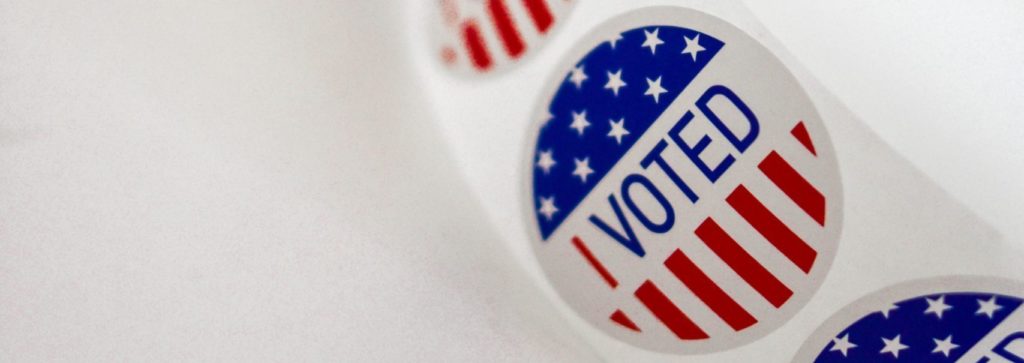
“My vote doesn’t matter.”
How many times have you heard someone say that voting doesn’t matter? How many times have you thought that yourself?
Evidence of defeated beliefs in our electoral system lies in the statistics. In the 2016 U.S. presidential election, 40% of Americans didn’t vote. In the 2018 U.S mid-term elections, 47% of eligible voters didn’t vote, and that was with an 11% increase in voter turn-out from the prior 2014 mid-terms.
Why aren’t people voting?
Voters worldwide have not only felt disappointed, but disenfranchised by the current structure of electoral systems. Voter ID laws, inaccurate voter purges, and gerrymandering are just some methods of voter suppression that disproportionally affect people of color. Those who do have voting access can feel disappointed in the electoral college with candidates being elected into office despite losing the popular vote. Two out of three previous presidents were elected based on having more electoral votes, but lost the popular vote by over 500,000 (Bush) and almost 3,000,000 (Trump) votes.
We face another harsh truth when we look at the number of wasted votes in primary elections. In the 2020 Democratic primaries for Washington state (where I live), over 25% of votes were wasted because the selected candidate had dropped out of the race. I know people who mailed in their ballot early, excited to vote for Elizabeth Warren, only to watch in distress as she dropped out of the race 5 days before ballots were due. Wasted votes occurred in 45 U.S. states this year (more on the other 5 later) leaving voters to feel disempowered or forced to compromise their choice based on “electability” of the candidate rather than values and political agendas.
Needless to say, you can hear the resounding disappointment from many American voters in this year’s 2020 presidential election where a field of the historically most diverse Democratic candidates became whittled down to Joe Biden, a white man in his 70’s with a politically moderate agenda. As we do our best this year in polling stations or mailing-in our ballots, let’s explore how future elections can give more power to voters with ranked choice voting.
Explanation of Ranked Choice Voting
Ranked choice voting allows you to rank multiple candidates in order of preference, instead of selecting just one single candidate. You get a 1st choice, 2nd choice, 3rd choice, and so on. You can rank up to as many candidates as you want. Or, you can even select just one candidate if preferred. While you’re ranking multiple candidates, your vote will only go to one candidate in the end.
Here’s a hypothetical ballot using trees in place of candidates. We are going to rank these “tree-candidates” based on order of preference. (Check out these prototypes of what a real ranked choice voting ballot could actually look like.)
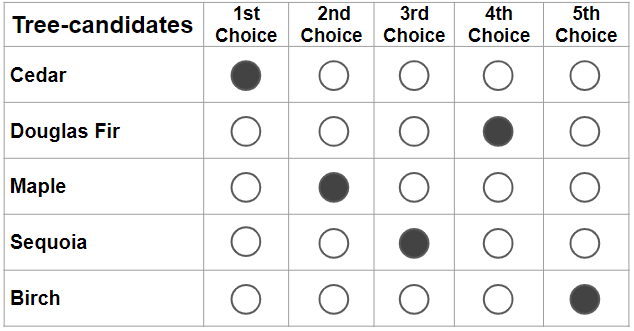
We choose to rank all 5 candidates, because let’s be honest, trees are awesome. We chose Cedar as our first choice, Maple as our second, Sequoia as our third, Douglas Fir as our fourth, and our last vote went to Birch. That wasn’t too hard, right?
All the other voters rank the “tree-candidates” in order of preference, and the votes are collected.
How Ballots Are Counted
The first step in the process is to count everyone’s 1st choice votes. In ranked choice voting, a candidate only wins when they have the majority of votes (over 50%). This is actually different than our current system. We currently run plurality elections where the candidate wins when they have more votes than all other candidates, they don’t have to have majority.
In the 2016 Republican primaries, less than 14 million Americans voted for Trump as their nominee and he won with 46.5% of the vote. Which means more Republican voters (53.5%) didn’t vote for Trump. The results of the 2016 Republican primary comes from plurality rules. In a majority rules election, Trump would have had to earn over 50% of the vote in order to become the Republican nominee.
In ranked choice voting, majority rules. A winner is declared when one candidate reaches over 50% of the vote. If after the 1st choices are counted and no candidates reach a majority, the candidate with the least number of votes is eliminated, and those votes will go to the voter’s second choice pick.
I spoke with Mohit Nair, Partnerships Director of FairVote Washington, a non-partisan non-profit dedicated to electoral reforms like ranked-choice voting and fair elections. Nair says: “One thing people get confused about is, ‘Wait a second, does this mean I get 5 votes, am I voting for 5 different people?’ No, you’re not. You’re still voting for one person, and your vote stays with your first choice until that candidate is either out of the running or no longer viable.”
Let’s explore how this works with our “tree-candidates.”
All of the 1st choice votes are counted and the results show Maple in the lead at 36% of the votes.
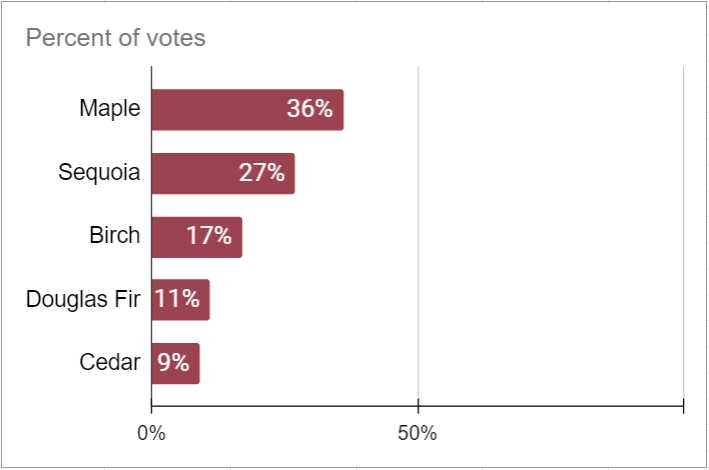
Since Cedar had the least number of votes, it’s eliminated from the running. But wait, we voted for Cedar as our 1st choice, so what happens to our vote? Our vote will now go to our second choice: Maple. This process repeats until one tree-candidate has over 50% of the vote. It’s possible that Maple maintains the lead and reaches majority after the second or third choice votes are counted. Or, it’s also possible that Sequoia receives more 2nd and 3rd choices and reaches majority to win.
Indeed, election outcomes have changed based on 2nd and 3rd choice votes. In 2018, Democrat Jared Golden won a Maine house seat after 2nd and 3rd choice voters were counted from eliminated independent candidates. In the first round, Golden trailed Republican incumbent Poliquin by 2,000 votes, but picked up enough 2nd and 3rd choice votes to win with a majority: 50.5% of the vote.
For people who say ranked choice voting sounds complicated, it’s really not. Co-founder of the Committee for Ranked Choice Voting Cara McCormick spoke with NPR about how we’re actually familiar with the process of ranking our preferences, “You know, we rank choices in our everyday life all the time. We’re always saying, you know, if they don’t have the mint chocolate chip ice cream, can you please get me the rocky road?”
Watching a visual explanation of ranked choice voting really helps understand the process. Check out this lovely 2 min video for more clarity.
Benefits of Ranked Choice Voting
Changing our electoral system to ranked choice voting would require time and effort, but not without plenty of benefits.
Ranked choice voting is nonpartisan, which means it doesn’t benefit one party over the other. It benefits all voters, by increasing their power and ability to elect representative candidates to office, whether they’re Democrat, Republican, Independent, Black, White, Latinx, Asian, Male, Female, or otherwise.
Relieves pressure to vote for the lesser of two evils
Many voters have begrudgingly submitted their ballot after voting for who they deemed “the lesser of two evils.” Their favorite candidate may have been less likely to win because they fall outside typical party standards, perhaps as a green party candidate or an independent, so they resigned their selection to the candidate they hated the least. Ranked choice voting allows us to vote for our first choice, knowing we have our 2nd choice as a backup in case our preferred candidate gets eliminated.
Decreases vote splitting
You may have heard of something called the “The Nader Effect.” In the 2000 Bush v. Gore election, Ralph Nader ran as the Green Party representative. In a close and questionable race, the Supreme Court stopped the recounting of Florida ballots and Bush was declared the winner by a margin of 537 votes. Nader received 97,488 Florida votes himself and was blamed for splitting the “left” vote and handing Bush the election. The same tension with vote splitting appeared in the 2016 presidential election where critics argued Green Party votes spoiled the election for Clinton and handed Trump the presidency. Vote splitting is a source of fear and frustration for those who either don’t want to vote for a Democratic or Republican party nominee, or don’t want third party choices to spoil the election.
Vote splitting also keeps diverse candidates from running against a candidate in their own political party. Some candidates may feel pressured to drop out for fear of taking votes away from their opponent in their shared political party, in order to mitigate the risk of the other political party winning. The pressure to not run or drop out of the race, significantly impacts underrepresented groups such as people of color and women.
Instead of criticizing those who either vote for or run as a challenger to a “more electable” candidate, ranked choice voting can alleviate vote splitting by giving voters a valid second choice, while still being able to honestly vote for their 1st choice.
Increases the diversity of candidates
Ranked choice voting in multi-winner (i.e. city councils) and single-winner (i.e. presidential) elections increases the ability for diverse groups of voters to elect their representative of choice.
A 2018 study showed that cities who adopted ranked choice voting saw increases in the number of candidates of color running for office and increased likelihood of females and females of color winning elections. Multiple studies also showed increased diversity in candidates and officials elected into office in jurisdictions that implemented ranked choice voting.
Increased diversity is one of Mohit’s favorite benefits of ranked choice voting. “We see more people of color running and winning in places that use ranked choice voting,” he says. Which is significantly impactful for multi-seat offices such as city councils, where demographic groups with a minority of the population don’t get representation because the majority demographic has more votes to elect their candidates of choice. “But with ranked choice voting, you have a situation where if your community group makes up 40% of the vote, that translates to 40% of the power, that means you can get 40% of the representation. Unlike our current winner-take-all system where 51% of the voters get 100% of the representation.”
Discourages negative campaigning
Negative ad campaigns focus on taking down the opponent, rather than the candidate’s own political agendas and policies. Name calling, insults, and information distortions are just some of the tactics candidates have used to sway votes away from their opponent. Research from the Wesleyan Media Project shows that political ads have become increasingly negative over the past few election cycles. In the 2016 U.S presidential election, the Wesleyan Media Project report showed that only 31% of Clinton’s ads were positive and Trump aired no positive ads at all.
Negative ad campaigns are damaging as they polarize candidates and respective political groups. This polarization shatters voters’ abilities to unite over the many values they actually share (i.e. health care reform and legal status for dreamers) and create lasting positive change. Studies also show that negative campaigning can lead to decreased voter turnout.
With ranked choice voting, candidates are incentivized to earn those 2nd and 3rd choice votes, and that’s hard to do when they’re attacking a voter’s #1 pick. A San Francisco mayoral race using ranked choice voting demonstrated just how civil a campaign could be with Democrats Jane Kim and Mark Leno campaigning together for voters 1st and 2nd choices.
Other benefits
- Saves taxpayer money
- Eliminates wasted votes
- Increased participation from military and overseas voters
- Promotes majority support
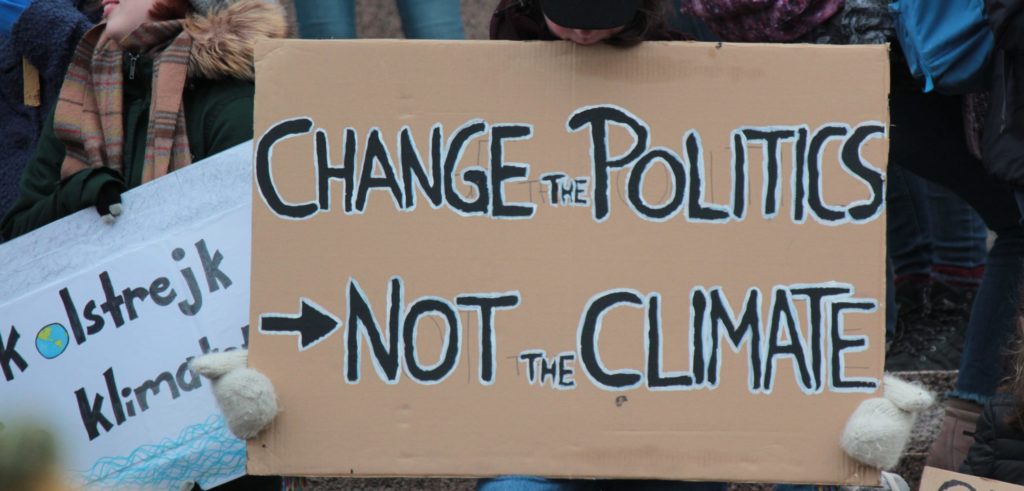
Jurisdictions Adopting Ranked Choice Voting
In the 2020 Democratic primaries, 5 U.S states (Alaska, Wyoming, Hawaii, Kansas, and Nevada) enacted ranked choice voting on their ballots, which meant no votes were wasted in those states.
Maine will be the first U.S state to use ranked choice voting in the upcoming presidential election this November.
Ranked choice voting is also used internationally in countries like New Zealand, Ireland, Fiji, and the U.K. In fact, Australia has been using ranked choice voting for over 100 years.
See the many other U.S and global locations where ranked choice voting is used.
Opposition to Ranked Choice Voting
A change to ranked choice voting would mean disrupting the status quo. Some people don’t like that.
There are multiple angles of pushback from opponents of ranked choice voting. I asked Nair to tell me more about the opposition’s concerns and possible reasons behind them.
“People won’t get it”
“One concern I hear that I don’t particularly love, is because it carries this racialized sense that communities of color won’t understand it. We often hear this from white male folks who very confidently say this is too complicated for voters to understand.” Nair explained there isn’t evidence to support this claim: “There are more than 20 places around the country that use it, it’s gaining traction, and voters do understand how to rank their choices by an overwhelming margin. That’s not to say you don’t need voter education, that’s always important. As long as you don’t undermine voter education and adequately budget for it, there’s no reason that communities of color or anyone will not understand how to rank their choices.”
“It’s too expensive”
Some people are concerned that changing our electoral system would require too much time and money, but this isn’t shown to be the case. “Now if you look at the number of jurisdictions, people have brought in ranked choice voting and introduced it at basically no additional cost. Santa Fe used it with approximately $10,000.”
New York City will begin to use ranked choice voting in 2021 and is projected to save $11 million in taxpayer money for each election cycle it replaces preliminary or runoff elections with ranked choice voting in the general election.
The Two Parties Push Back
Ranked choice voting can be a threat to whichever political party currently holds power. The Republican party is a frequent opponent of ranked choice voting, but not always. Utah Republicans advocate for ranked choice in their elections. Additionally, the Democratic party doesn’t always show their support. In 2019, California’s Governor Newsom (Democrat) vetoed a bill which would have allowed ranked choice voting throughout the state. It’s clear ranked choice voting is a nonpartisan issue.
Another reason Democrats and Republicans may resist ranked choice voting is to suppress votes for minority parties. Independent and Green Party candidates have more of a chance in local elections using ranked choice voting, “Under the single winner form of ranked choice voting, you still won’t see independent third parties come into play, but in local offices with enough seats on the table, you could start to see some third parties come into the picture. And that’s what might have contributed to the pushback,” Nair says.
Current Resistance in Massachusetts
Ranked choice voting is on the Massachusetts ballot this November. Depending on the results, Massachusetts could be the 2nd state to implement ranked choice voting state-wide. Read this article by Elizabeth Warren advocating for ranked choice voting in Massachusetts (her home state). But it’s facing opposition.
“A lot of Republicans have come out against it. They’ve falsely claimed that it is confusing for voters. Some people will disingenuously argue that it doesn’t benefit communities of color.” Nair discredits the claims: “As long as you invested adequately in voter education, you’d be hard pressed to find an example where it’s actively disenfranchising people of color compared to the current system.”
The strategic re-framing of the ranked choice voting initiative is one tactic used to sway voters with inaccuracies. “It really just becomes a racist dogwhistle to be honest, when it’s directed to communities of color,” Nair explains.
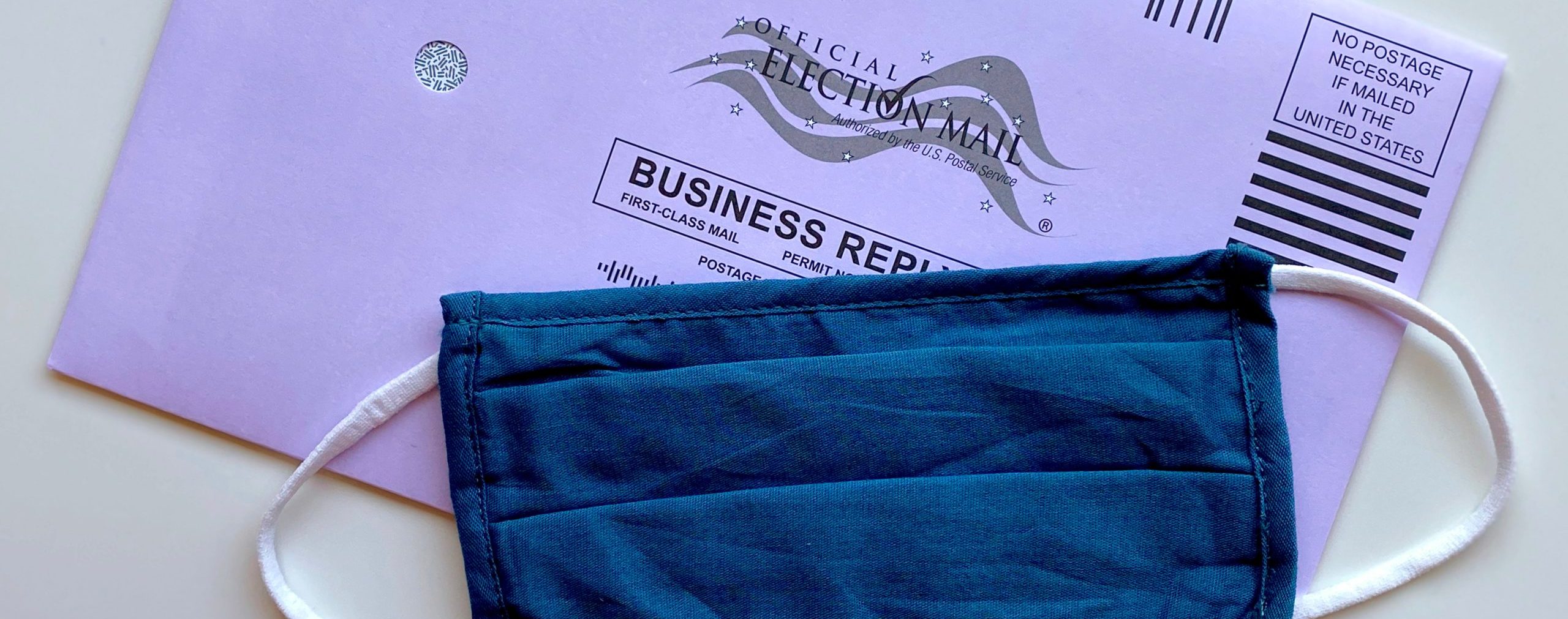
What’s Next for Ranked Choice Voting
The future looks bright for ranked choice voting.
“I think it’s something that’s gaining more and more traction,” Nair says, “It’s gaining a lot of momentum. Across the state and across the country.”
It’s being used this November in Maine. It’s on the ballot in Massachusetts. Five U.S. states used ranked choice voting for their democratic primary. Other states are also making headway. Washington state is working on a local options bill that would allow jurisdictions to use ranked choice voting.
Feeling Hopeful
I asked Nair what keeps him hopeful for our elections in the midst of political turmoil. “I think seeing the kind of volunteers in the movement, really really keeps me hopeful…I see educators, who have formed their own Educators for Ranked Choice Voting group. They’re teachers who put in 12 hour days, and then come back and look at how they can bring ranked choice voting to Washington.”
The power really comes down to the people.
Mohit shares, “It’s citizen-led movements and seeing that people want to change the system, people recognize the problems that they have, they’re fighting systemic issues, organizing, getting out there on the streets and holding people accountable, that’s what keeps me motivated. Because it’s so clear that it’s going to come. Because whatever the issue, civil rights weren’t handed to us by people in charge, you had to fight for it, and continue to fight for it.”
What We Can Do
- Support FairVote WA or a nation-wide organization for ranked choice voting like FairVote
- Attend online webinars and trainings (check these webinars out)
- Donate!
- Educate yourselves, friends, and families about ranked choice voting
- Write to legislators
- Help gather signatures to get ranked choice voting on your state’s ballot
Must-have resources on ranked choice voting
- FairVote
- “We’re Doing Elections Wrong” with Hasan Minhaj on The Patriot Act
- YouTube video by NBCLX: Is Ranked Choice Voting a Better Way to Pick a President?
- Ranked choice voting resource center
- Elizabeth Warren article
__
Photo: Unsplash; Graphics: Lindsay Brave




